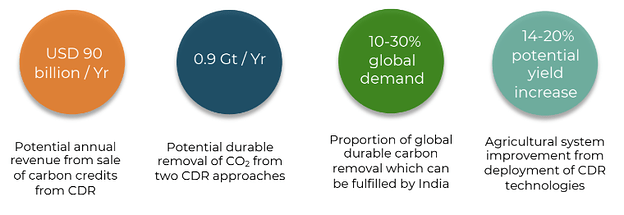In a white paper that it has published on its website, ‘Durable Carbon Dioxide Removal in India: The Opportunity to Lead the World While Improving Agricultural Systems, Increasing Export Revenue and Generating Jobs’, the Carbon Removal India Alliance has laid down how India can become a global leader in CDR while strengthening local agriculture, augmenting export income and creating employment.
Key takeaways from the whitepaper:
- Reducing the amount of emissions is not sufficient for countering climate change owing to the presence of the so-called ‘legacy emissions’.
- In addition, some emissions originating from hard-to-abate sectors cannot be avoided.
- The IPCC has stressed ‘the need to remove between 4.7 to 9.8 billion tons of carbon dioxide from the atmosphere each year by 2050’.
- India can potentially provide around 10-30% of the permanent CDR that is needed at the global scale.
- Thanks to its efficient natural resources, the innovative technologies that are at its disposal and the accelerated pace at which it engages in policy-making, India can reach its climate goals while playing a leading role in managing carbon.
- The establishment of a CDR sector can create employment, income and considerably enhance the state of agriculture. In addition, it can significantly increase the amount of foreign exchange at the disposal of India and expand the volume of exports that originate from India.
- However, the aforementioned goals can only be realized if the following conditions are met:
- The objectives set for CO2 reduction and CO2 removal should be separated.
- Natural CDR approaches with low durability should be distinguished from the technological CDR methods that possess high durability.
- Steps should be taken to ensure that there is an environment inductive for the creation and assessment of different CDR technologies.
- The significance of the permanence of CDR as well as the possibility of reversal should be recognized.
- All social and environmental risks at play should be considered.
- Awareness should be raised among crucial stakeholders regarding CDR including policy-makers, media and businesses.
- Uncertain aspects of India’s agricultural and biochemical systems should be explored.
- It should be acknowledged that the understanding of CDR will evolve as society obtains more knowledge regarding the Earth System.
- A governmental body tasked with coordinating the efforts geared towards creating incentives that remove the obstacles that stand in the way of developing CDR should be established.
- India should sell CDR credits to corporations established abroad so as to increase the export revenue of India. This situation can also enable India to reach its Net Zero objectives.
Read the white paper here: https://www.cria.earth/#:~:text
